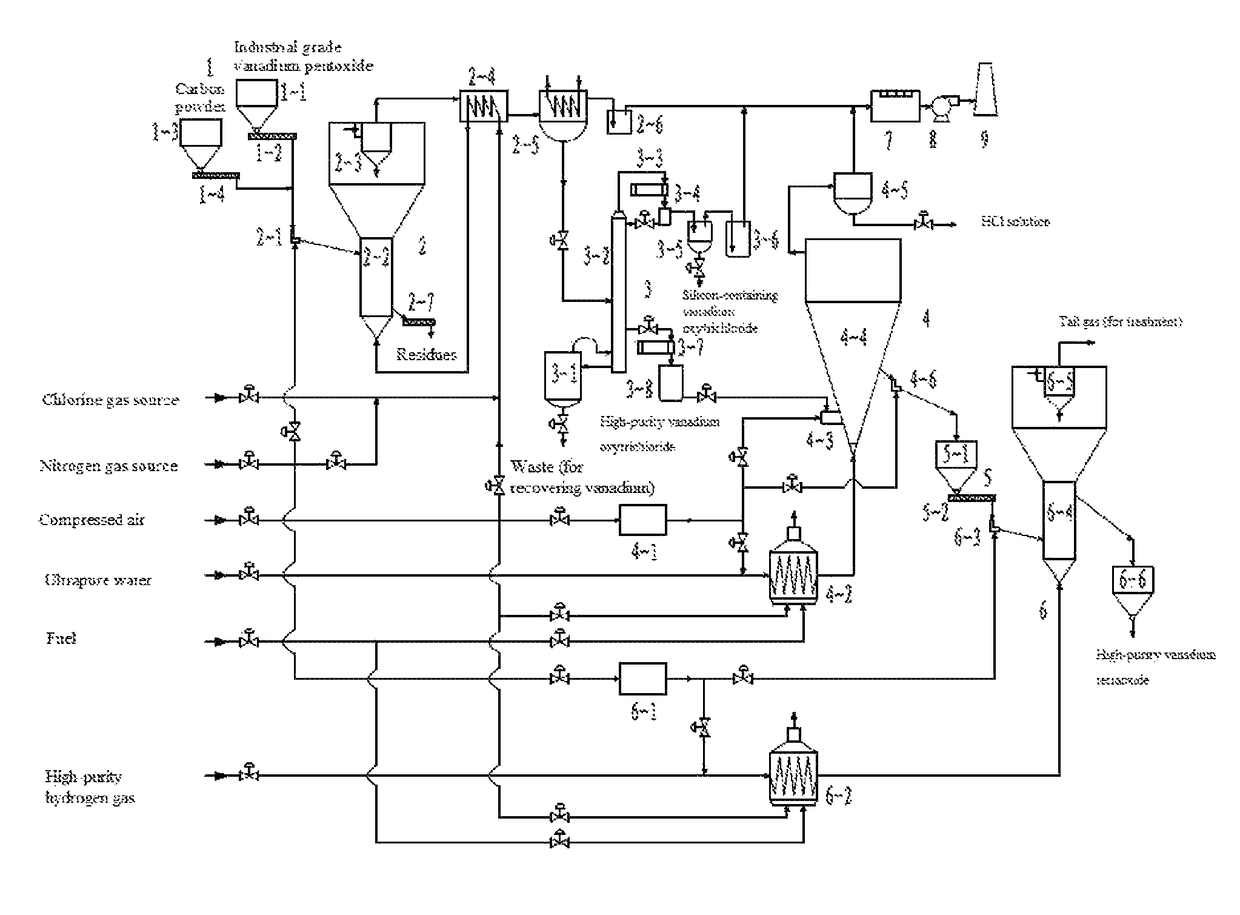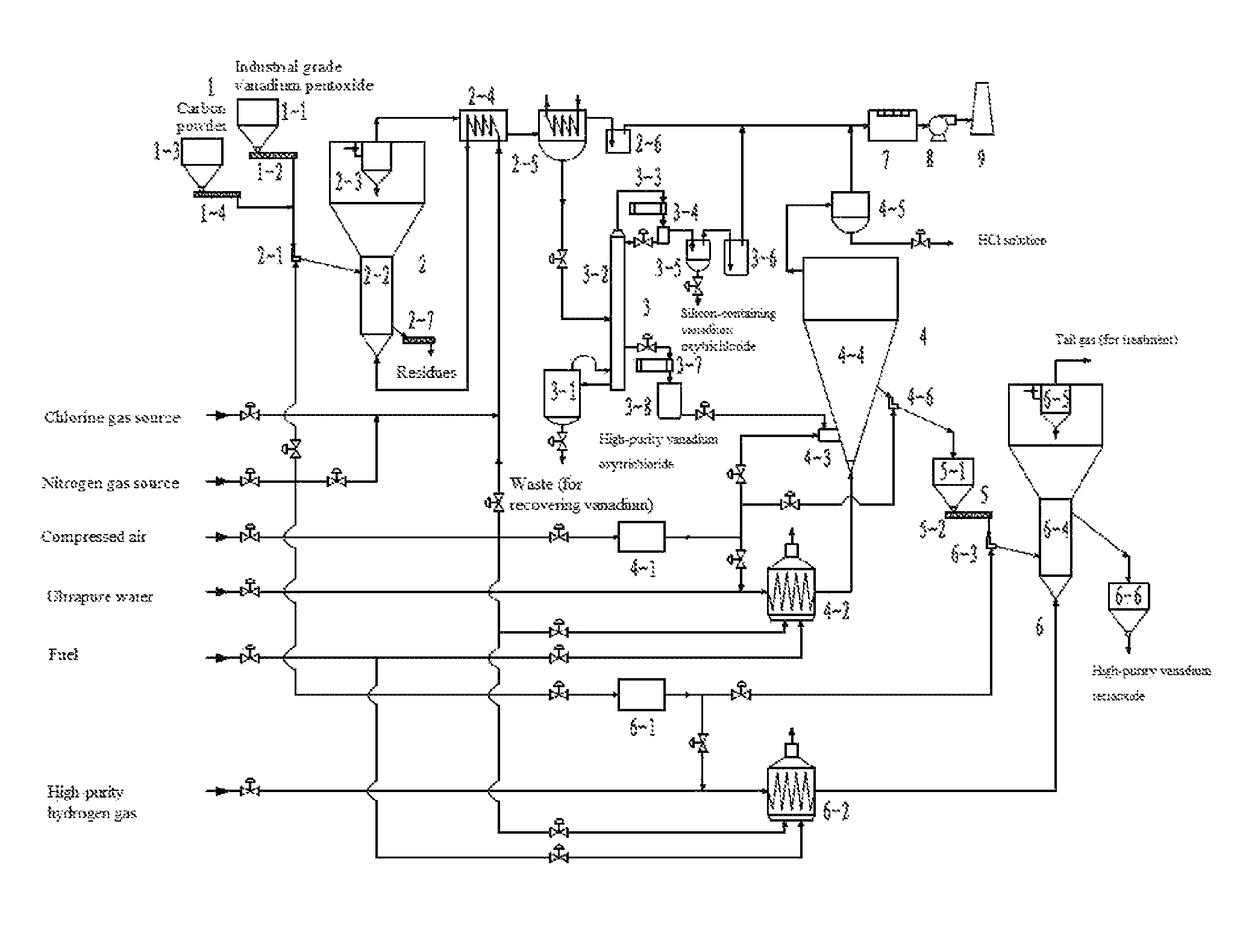However, in general, only vanadium
pentoxide with a purity of 2N5 (i.e. the product according with the specification in HGT 3485-2003) can be prepared by the existing
industrial technology, which is difficult to meet requirements on vanadium pentoxide for the battery industry.
Moreover, the
calcium salt and
magnesium salt scavengers or extractants, the acid and alkali reagents and
ammonium salts for vanadium
precipitation used in the purification process are also liable to introduce impurities.
In order to improve the quality of the product, it is usually required to use expensive reagents with high purity, thereby leading to the following problems: the cost is too high, large-scale production cannot be implemented and the purity of the product is difficult to stabilize at above 3N5.
However, the
dissolution-
precipitation process still requires use of a large quantity of high-purity acid and alkali reagents and
ammonium salts, therefore the cost of purification is still high; and the cumbersome multiple
precipitation operations not only lower the production efficiency but also lead to a significant decline in the direct
recovery rate of vanadium.
In addition, in the above-mentioned solution
purification methods, extraction / back extraction, precipitation, washing and other operation steps will produce a large amount of waste water mainly containing a small quantity of vanadium ions and
ammonium ions and a large amount of
sodium salts, which results in difficult treatment and outstanding problem of
pollution and also seriously restricts the large-scale industrial application of the methods.
However, a large amount of
wastewater containing
ammonia and
nitrogen will be produced in the precipitation and the washing processes (at least 1.8
ton of
ammonium chloride waste salt is produced per
ton of a vanadium pentoxide product), leading to difficult treatment; and the precipitation,
drying and
calcination processes of ammonium salts not only require
high energy consumption, but also easily cause environmental
pollution.
In addition, the study only realizes the intermittent preparation of high-purity vanadium pentoxide by the chlorination method with the laboratory equipment, and cannot provide related information on how to use the chlorination method for continuous preparation of high-purity vanadium pentoxide on an
industrial scale.
It may be for exactly these reasons that the report on continuous preparation of high-purity vanadium pentoxide by the chlorination method is difficult to find in the decades after the study.
Therefore, a particular vanadium raw material cannot be directly applied to
rotary kiln, fluidized furnace, boiling furnace,
shaft furnace, multi-
hearth furnace and other reactors.
Moreover, the “fluidized furnace” and “boiling furnace” are essentially the same, just different in names; therefore, since these reactors vary widely in
operation mode and condition, the method cannot actually be implemented on the condition that only basic flow is provided.
However, because vanadium pentoxide is easily dissolved in the
hydrochloric acid solution, the
recovery rate of precipitation of vanadium is too low.
Moreover, in the
hydrochloric acid solution with an HCl concentration more than 6.0 mol / L, when vanadium pentoxide is dissolved, it will be reduced to VOCl2 and
chlorine gas is released, which will further reduce the
recovery rate of precipitation of vanadium.
Precipitation and washing processes will inevitably produce a large amount of hydrochloric acid solution containing vanadium, and it is difficult to effectively achieve a comprehensive treatment.
In addition, for large-scale industrial applications, there still exists the following two problems in the existing technologies for chlorination of vanadium raw materials: (1)
calcination for chlorination of vanadium raw materials is a strong
exothermic process, and in addition to preheating the
solid and gas reaction materials, the heat generated by the chlorination reaction still needs to be removed by furnace wall heat dissipation to stabilize the temperature in the chlorination; therefore, both the
solid and gas are usually enters the reactor at a temperature of near
room temperature, and only can participate in the reaction after been preheated by the heat produced from the chlorination reaction, resulting in too low efficiency of reaction in part of the chlorination reactor; (2) since the heat produced by the chlorination reaction needs to be removed through dissipation of a large amount of heat to maintain the
operation temperature, the operating condition and environmental
climate change are both liable to cause fluctuations in chlorination temperature, resulting in reduction of selectivity in chlorination and efficiency, and it is needed to use a reasonable method for balanced supply of heat and temperature regulation.
It can be seen that the prior art still mainly focuses on the preparation of high-purity vanadium pentoxide and is difficult to achieve large-scale application due to the presence of significant deficiencies.
 Login to View More
Login to View More 

